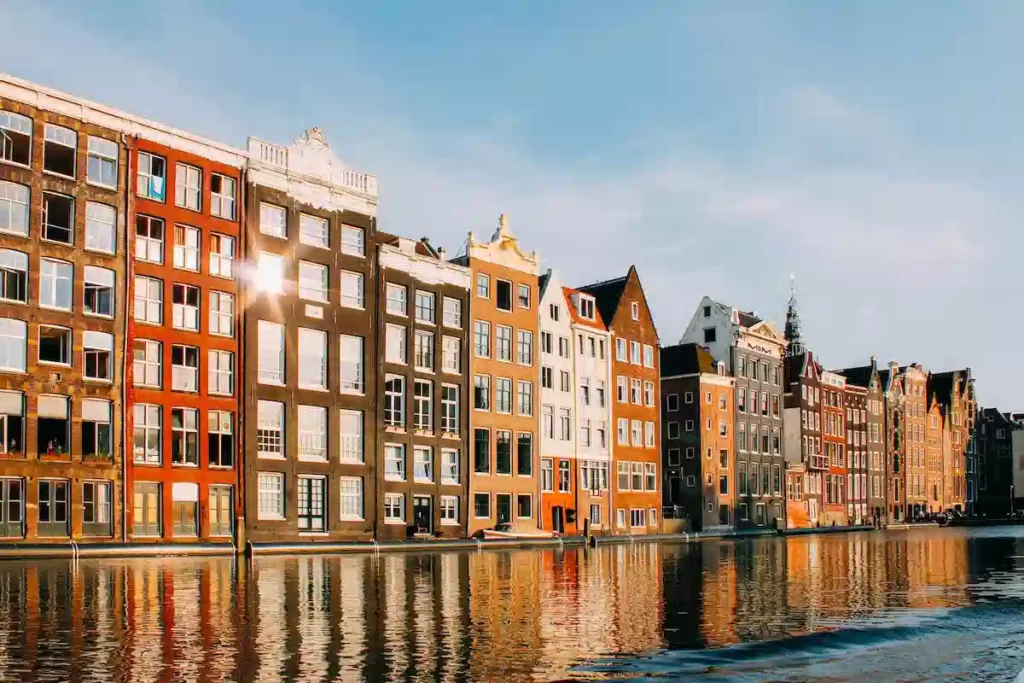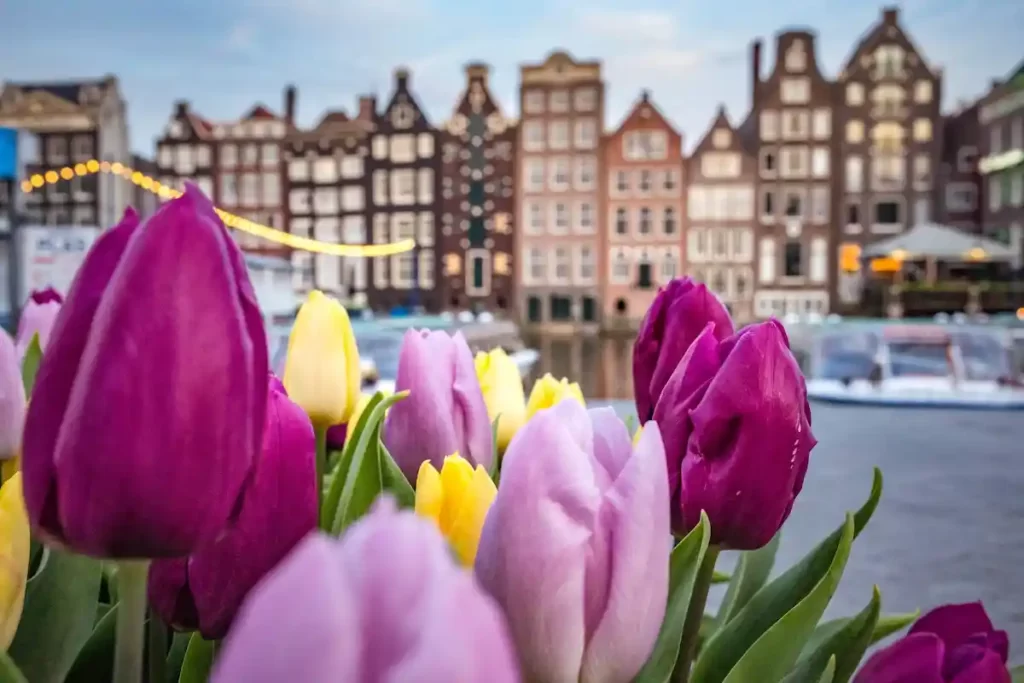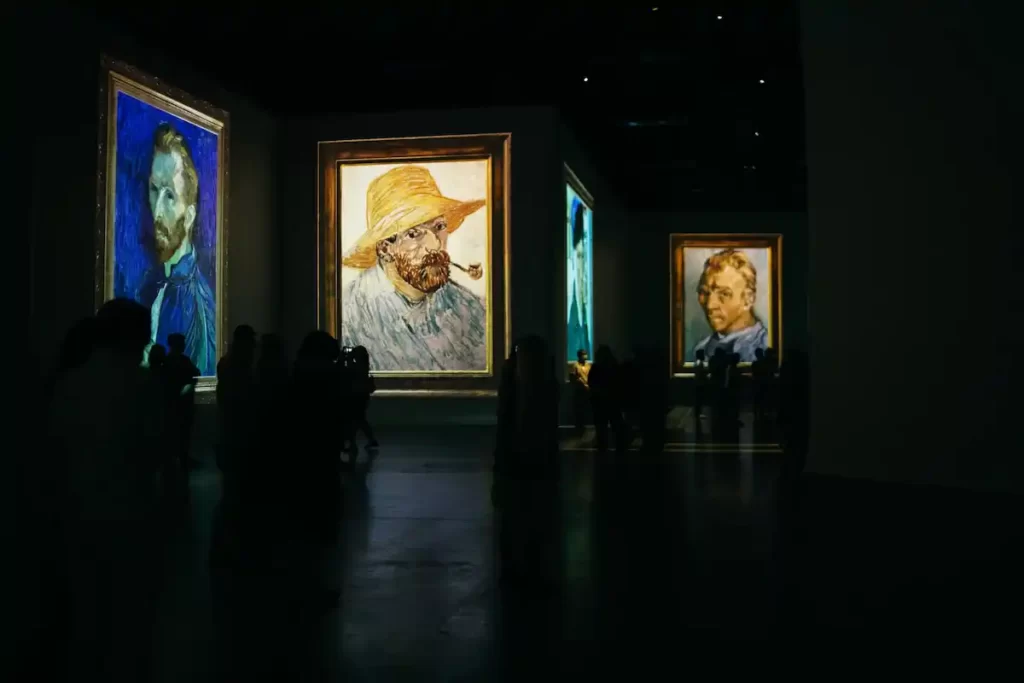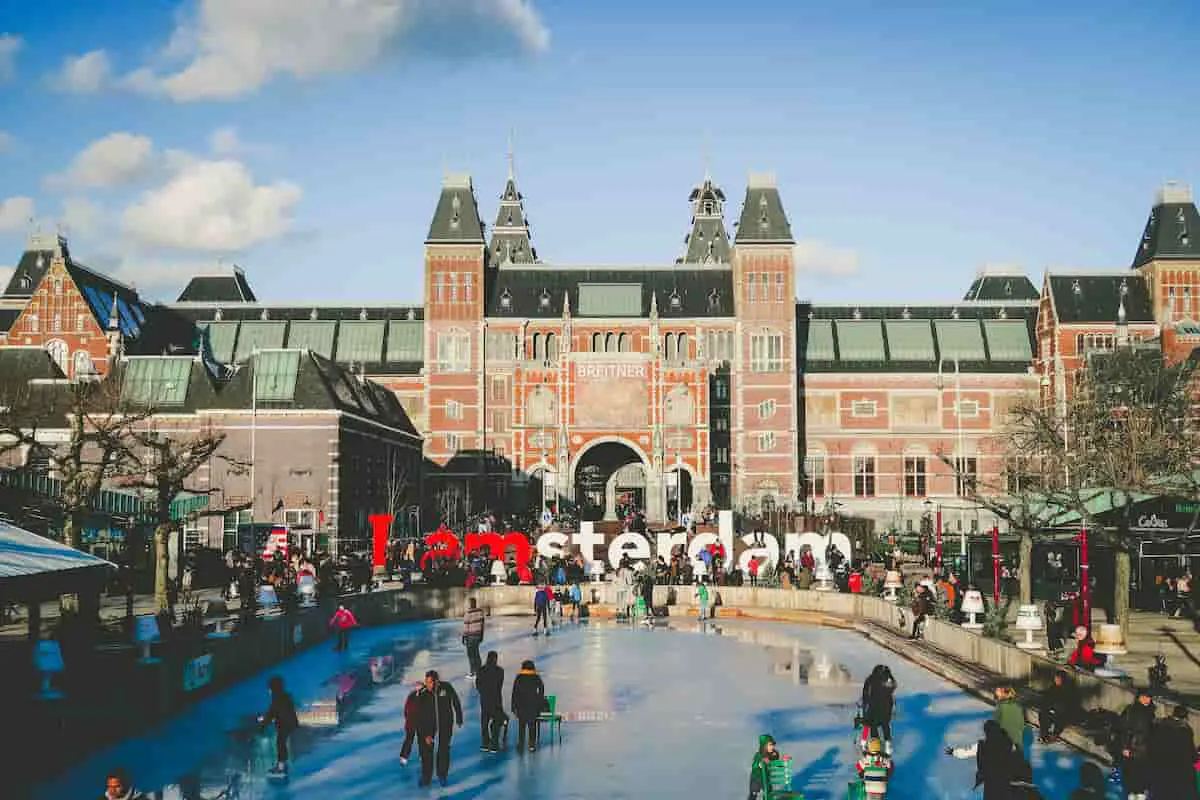Here, we list 20 reasons to make Amsterdam your next travel destination. Unknown to many, the city boasts numerous tourist attractions and offers unique experiences found nowhere else in the world.
Affectionately dubbed the “Venice of the North”, Amsterdam is steeped in a rich blend of sorrowful and joyous tales that have sculpted the city and the Netherlands as we know it today.
Amsterdam radiates an undeniably Dutch atmosphere, marked by tranquility, eccentricities, and distinctive legalization.
While we’ve handpicked 20 reasons to visit Amsterdam, rest assured, there are countless more awaiting your discovery as you stroll through its historic streets and buildings dating back to the 16th century!

Anne Frank’s History
Delve deep into the life of Anne Frank, the Jewish girl who chronicled her life during the Holocaust in WWII. The city was a haven for Jews fleeing Nazi persecution, and in Amsterdam, you can explore the Anne Frank House and museum filled with artifacts and stories.
Anne Frank was a Jewish teenager who went into hiding with her family during the Holocaust to escape persecution by the Nazis. Born in Frankfurt in 1929, her family moved to Amsterdam in 1933 to escape the growing anti-Semitic sentiments in Germany. However, when the Nazis occupied the Netherlands in 1940, the Frank family’s safety was again at risk.
In 1942, Anne, along with her parents, sister, and four other Jews, went into hiding in a secret annex behind her father Otto Frank’s office. During her time in hiding, Anne wrote in her diary, documenting her experiences, fears, and the complexities of growing up in such circumstances. Her writing showcased her insightful observations, the internal conflicts of a teenager, and the horrors of war.
Unfortunately, in 1944, the group was betrayed and arrested. Anne and her sister Margot were eventually transferred to the Bergen-Belsen concentration camp, where they both died of typhus in early 1945, just a few months before the camp was liberated.
Anne’s diary, discovered by her father (the only surviving member of the family), was published as “The Diary of a Young Girl” and has since been translated into many languages. It serves as a poignant symbol of the Holocaust and a testament to the human spirit in the face of profound adversity.
See the architecture when you visit Amsterdam:
Amsterdam’s distinctive narrow houses and streets speak to its architectural heritage. Intriguingly, some houses have the world’s narrowest facades, a design choice resulting from 16th-century taxes based on facade width.
The city also showcases over a millennium of architectural evolution, from medieval to renaissance and modern designs.
Artistic Excellence. A reason to viit Amsterdam
Amsterdam thrives as a hub for contemporary and modern art. Visit cultural institutions like FOAM and various art galleries. Pioneering artists like Vincent van Gogh and Johannes Vermeer once called the city home.
Bicycle Rides:
Bicycles are integral to Amsterdam’s culture. With more bikes than inhabitants, the city encourages tourists to explore its sights on two wheels, with numerous rental and guided bicycle tour options.
Amsterdam, often hailed as the “Bike Capital of the World,” boasts a cycling culture that’s deeply embedded in its urban fabric. With over 800,000 bicycles, the city has more bikes than residents! This love for cycling is not recent; it’s a relationship that began in the 19th century. But it wasn’t always smooth riding.
In the 1960s and 70s, as cars became popular, Amsterdam’s narrow streets became congested, leading to many fatal accidents. Public uproar over child traffic deaths, combined with the oil crisis of the 1970s, catalyzed the city’s shift towards becoming bike-friendly. Campaigns such as “Stop de Kindermoord” (Stop the Child Murder) exerted pressure on the government to improve cycling infrastructure.
The city responded by reducing car traffic in the city center, implementing wide-ranging bike lanes, and promoting bicycle usage for all age groups. Over the decades, cycling became not just a mode of transportation but a way of life and an embodiment of Dutch efficiency and environmental consciousness.
Today, about 63% of people use their bikes daily. They cycle to work, drop their kids at school, and carry groceries. The flat terrain, compact urban design, and extensive cycling infrastructure make it easy and safe.
The city continues its commitment to promote cycling, reducing carbon footprints, and ensuring Amsterdam remains a livable and sustainable city for generations to come.
Bloemenmarket
Experience the world’s only floating flower market. Open all year round, the market retains its old-world charm, reminiscent of the days when stalls awaited replenishment by boats.
The Bloemenmarkt, situated in Amsterdam, stands as the world’s only floating flower market. Established in 1862, it’s a reflection of the Netherlands’ deep-rooted floral culture, especially its tulip obsession which dates back to the 17th-century tulip mania.
Located on the Singel canal, the market features a series of houseboats where a myriad of flowers, bulbs, and souvenirs are sold. From vibrant tulips in spring to festive ornaments in winter, the Bloemenmarkt offers seasonal allure.
Tourists and locals alike are captivated by its colorful displays and the unique setting on the water. In addition to flowers, one can find traditional Dutch souvenirs, making it a popular spot for gifts.
While the market has faced challenges from rising tourism and commercial pressures, it remains a cherished emblem of Amsterdam’s rich horticultural heritage and its intimate relationship with canals.
Amsterdam Canals
Amsterdam’s iconic canals are an integral part of its historic and cultural landscape. Built during the 17th century, the “Golden Age,” they reflect the city’s wealth and blossoming trade relations.
The Grachtengordel, a network of intersecting waterways, is organized in concentric rings and was added to the UNESCO World Heritage List in 2010. Besides functioning as transportation routes, these canals were crucial for water management and defense.
Today, lined with picturesque narrow houses and over 1,500 bridges, they provide a unique ambiance that captivates residents and tourists alike. Popular for canal cruises, these waterways offer views of the city’s historic architecture, bustling street life, and serene reflections.
Whether you’re leisurely strolling along their banks, cruising on a boat, or crossing one of their many bridges, the Amsterdam canals encapsulate the city’s timeless charm and enduring spirit.
Houseboats
Amsterdam’s houseboats are a distinctive feature of the city’s waterways. Originally introduced in the 20th century as a solution to housing shortages, these floating homes have since become emblematic of Amsterdam’s innovative spirit and love for the water.
Moored along the city’s many canals, houseboats range from converted old cargo ships to purpose-built floating homes. Over time, what began as a practicality has evolved into a coveted lifestyle; residents appreciate the unique charm, waterfront views, and close-knit community feel.
For tourists, some houseboats function as bed-and-breakfasts, offering a novel accommodation experience. These floating homes, often adorned with plants, bicycles, and personal touches, reflect the harmonious blend of historical and contemporary Amsterdam.
A walk or cruise along the canals isn’t complete without admiring these iconic waterborne residences, which add to the city’s rich tapestry of culture and tradition.
Dutch Beers – Visit Amsterdam
The Dutch are renowned brewers. Indulge in the Heineken Experience, or sample unique Dutch craft beers found only in local taverns.
The Netherlands, though often overshadowed by its Belgian neighbor, has a rich brewing heritage. Dutch beers have a history stretching back centuries, with monastic brewing traditions producing revered trappist ales like La Trappe.
The country is best known for its strong ales, seasonal brews, and innovative craft beers. Heineken, originating in Amsterdam in 1864, is perhaps the most iconic Dutch beer and has a global footprint.
Yet, beyond the big names, a plethora of smaller breweries like Brouwerij ‘t IJ and De Molen showcase the Dutch knack for craftsmanship and innovation.
These craft breweries often experiment with flavors, producing IPAs, stouts, and barrel-aged wonders. The annual Bokbier Festival in Amsterdam celebrates the release of “Bokbier”, a seasonal favorite.
Paired with traditional Dutch snacks, enjoying a beer in the Netherlands becomes an experience that merges tradition with contemporary tastes. The Dutch beer landscape, thus, beautifully balances age-old brewing techniques with modern creativity.
Culinary Delights
Relish Amsterdam’s gastronomic offerings, from delightful poffertjes (mini pancakes) to the crunchy Bitterballen and sweet Stroopwafel.
Amsterdam, the vibrant capital of the Netherlands, boasts a culinary tapestry that reflects its rich history and cosmopolitan spirit. Historically, the Dutch Golden Age brought spices and ingredients from colonies, influencing Amsterdam’s palate. Traditional foods are hearty and simple, with an emphasis on quality ingredients.
Stamppot, a mashed dish with vegetables like kale or sauerkraut, speaks of cold winter nights. Herring, served raw with onions and pickles, remains a beloved snack, showcasing Amsterdam’s maritime legacy. For the sweet-toothed, stroopwafels – two thin waffles glued with caramel-like syrup – are a delightful indulgence. Amidst the old, international flavors thrive, thanks to the city’s multicultural residents.

Cheese, a Dutch hallmark, finds its pride in shops and markets, with wheels of Gouda, Edam, and Leyden gracing stalls. Then there’s the Indonesian rijsttafel, a legacy of colonial times, where an array of small dishes like satay and pickled vegetables are served with rice.
Amsterdam’s food scene, much like its canals, winds through tradition and innovation, offering bites that warm the soul and dishes that surprise the senses.
5 Most Important Foods:
- Haring (Raw Herring)
- Stroopwafel (Caramel Syrup Waffle)
- Stamppot (Mashed Potatoes with Vegetables)
- Dutch Cheese (e.g., Gouda, Edam)
- Bitterballen (Meat-based Fried Snacks)
King’s Day in Amsterdam
King’s Day, originally Queen’s Day until 2013, is a national holiday in the Netherlands, celebrated on April 27th (or April 26th if the 27th falls on a Sunday). It marks the birthday of King Willem-Alexander and serves as a spirited show of Dutch national pride.
In Amsterdam, King’s Day is nothing short of a citywide extravaganza. The canals brim with boats, as orange-clad revelers celebrate on water and land alike. The color orange, symbolic of the Dutch Royal House of Orange-Nassau, becomes a ubiquitous sea across the city, with people donning orange hats, shirts, and accessories.
Vrijmarkt, the nationwide flea market, is a King’s Day highlight. Amsterdam’s streets and parks transform as locals lay out blankets, selling trinkets, toys, and homemade foods. Bargaining becomes a sport, and treasures are found amidst piles of second-hand goods.
Live music and performances erupt across the city’s squares, parks, and alleyways. DJs play to dancing crowds, while bands and buskers bring a diverse musical feast to the streets.
For children, games and activities sprawl out, from sack races to face painting. Meanwhile, adults might sip on “oranje bitter”, a traditional orange-colored liqueur.
King’s Day in Amsterdam is a vivacious blend of community, commerce, and carnival. For a day, routine takes a backseat, and the Dutch spirit of gezelligheid (conviviality) reigns supreme.
Museums to Visit in Amsterdam
Amsterdam, often dubbed the “Venice of the North,” is not just famous for its picturesque canals but also its rich repository of art, history, and culture housed within its numerous museums.
The city’s Golden Age legacy can be witnessed in its prestigious art institutions that host works from world-renowned artists, while other museums document Amsterdam’s unique historical and cultural tapestry.
The Rijksmuseum stands as an iconic institution, holding a vast collection of art and historical artifacts, with masterpieces from Rembrandt and Vermeer.
The Van Gogh Museum is another jewel, dedicated to the troubled genius and his contemporaries. Anne Frank House provides a poignant glimpse into the harrowing tale of the Jewish teenager during World War II.
The Stedelijk Museum showcases modern and contemporary art, while the NEMO Science Museum offers interactive exhibitions, making science accessible to all ages.
Beyond these, Amsterdam boasts specialized museums from handbags to houseboats, highlighting its diverse cultural palate and intrinsic eccentricity.
Important Museums in Amsterdam:
- Rijksmuseum
- Van Gogh Museum
- Anne Frank House
- Stedelijk Museum
- NEMO Science Museum.
Parks in Amsterdam
Amsterdam, while celebrated for its historical architecture and canals, also offers an array of verdant spaces providing respite from the urban bustle. These parks, with their expansive lawns, serene ponds, and charming pathways, serve as social hubs where locals and tourists gather for picnics, sports, or simple relaxation.
Vondelpark, the city’s largest and most famous park, teems with life, hosting open-air concerts, sculptures, and numerous cafes.
The Westerpark, originally a gasworks site, is now a vibrant blend of green areas, modern architecture, and cultural venues. Sarphatipark in the De Pijp district is a quaint haven in the midst of the bustling city.
Rembrandtpark offers a quieter alternative to Vondelpark, with its picturesque ponds and pathways. Beatrixpark, named after the Dutch queen, is characterized by its neat design and peaceful ambiance.
Each park is unique, echoing Amsterdam’s harmonious blend of history, nature, and modernity.
Important Parks to Visit in Amsterdam:
- Vondelpark
- Westerpark
- Sarphatipark
- Rembrandtpark
- Beatrixpark.
Cheeses in Amsterdam
Amsterdam, often recognized for its canals and art, is equally renowned for its rich cheese heritage. The Dutch have been producing cheese since 800 B.C., and this tradition has deeply embedded itself into the culture of Amsterdam and the broader Netherlands.
A visit to the city is incomplete without tasting the iconic Gouda (pronounced ‘how-da’ by the Dutch), a semi-hard cheese known for its rich, buttery flavor. It varies in taste depending on its aging process, from mild to extra matured.
Edam, another famous name, is a spherical cheese that’s slightly salty, and its taste intensifies as it matures. For something creamier, Leyden cheese, infused with cumin seeds, offers a unique flavor experience.
Maasdam is the Dutch answer to Swiss cheese, characterized by its large holes and nutty taste. And for those adventurous in palate, Limburger, with its strong aroma but milder taste, is a must-try.
Strolling through Amsterdam’s streets, you’ll find “kaas” shops at every corner, selling an array of these cheeses alongside other varieties. Moreover, cheese markets, museums, and tasting tours provide tourists an immersive experience into Amsterdam’s cheesy legacy.
Must-Try Cheeses in Amsterdam:
- Gouda
- Edam
- Leyden
- Maasdam
- Limburger.
Wooden Clogs (Klompen) in The Netherlands
Wooden shoes, or “klompen,” are a quintessential symbol of Dutch culture. Historically crafted from willow or poplar wood, these clogs have been worn by the Dutch since medieval times. Practical and durable, they were the preferred footwear for peasants and workers, protecting feet from sharp objects and dampness.
The simple design, consisting of a carved wooden sole and an upward-extending front piece, has remained largely unchanged over centuries. Over time, klompen transitioned from utilitarian necessities to cultural icons.
They are now often painted with intricate designs, making them popular souvenirs for visitors. Today, while they are less common as everyday footwear, they still hold ceremonial and cultural significance.
Some craftsmen continue the tradition of hand-carving clogs, demonstrating this unique craft to tourists. Whether in museums, traditional dances, or on the feet of farmers, the enduring presence of klompen reflects the Netherlands’ rich heritage.
Tulips in Amsterdam
Tulips are emblematic of the Netherlands, and Amsterdam is often at the heart of this floral fascination.
Originating from the Ottoman Empire, tulips arrived in Amsterdam in the 16th century, triggering the famed “Tulip Mania” in the 1630s, where bulb prices skyrocketed before dramatically collapsing.
The Keukenhof Gardens, located near Amsterdam, is one of the world’s largest flower gardens, showcasing millions of tulips every spring. Annually, between March and May, the city celebrates the tulip season, with vibrant blooms adorning public spaces, gardens, and homes.

Amsterdam’s Tulip Museum offers insights into the flower’s history and significance in Dutch culture. Furthermore, the annual “Tulip Festival” ensures that every bridge, park, and canal in the city gets adorned with these iconic blooms.
For many, a visit to Amsterdam in spring is incomplete without witnessing the kaleidoscope of tulips painting the landscape.
Van Gogh
Vincent van Gogh, the iconic Dutch post-impressionist painter, has left an indelible mark on the world of art.
While he lived and worked in various parts of the Netherlands and France, Amsterdam is home to the Van Gogh Museum, which houses the largest collection of his works. Situated in the Museumplein, this museum showcases a vast array of Van Gogh’s paintings, drawings, and letters, offering a deep dive into his tumultuous life and evolving artistry. Key masterpieces like “Sunflowers”, “The Bedroom”, and “Almond Blossom” are displayed here.
Through the exhibits, visitors journey through the artist’s struggles, his experiments with color and technique, and the influences of contemporaries. The Van Gogh Museum stands not just as a tribute to a single artist’s genius but as a testament to Amsterdam’s vibrant and enduring commitment to the arts.

Nightlife
Amsterdam promises a vibrant nightlife with eclectic bars, clubs, and events.
Amsterdam’s nightlife pulsates with energy, offering a diverse range for every type of reveler. The city is famed for its historic brown cafes, cozy spots ideal for enjoying a beer and conversation.
For those seeking music, the Leidseplein and Rembrandtplein areas brim with clubs playing everything from electronic dance music to live bands. Amsterdam’s world-renowned Red Light District becomes particularly lively at night, with its unique mix of bars, shows, and neon-lit windows. Canal cruises by moonlight offer a romantic twist, providing a serene backdrop to the city’s bustling scene.
The Jordaan district offers trendy bars and pubs, perfect for those seeking a laid-back evening. With an array of festivals, theater shows, and late-night cafes, the city promises a memorable night out.
Whether it’s dancing until dawn, enjoying craft cocktails, or just watching the world go by, Amsterdam’s nightlife doesn’t disappoint.
Red Light District
Experience the world-famous district, a testament to Amsterdam’s liberal stance since the 14th century. Just remember, no photos!
The Red Light District, locally known as “De Wallen,” is one of the most famous and oldest parts of Amsterdam. Located in the city center, it has become synonymous with the city’s liberal approach to adult entertainment.
This area is known for its illuminated red windows showcasing sex workers, who legally offer their services in well-regulated conditions. Besides the windows, the district hosts numerous sex shops, theaters, and museums, including the popular Museum of Prostitution, offering insight into the lives of the workers in a respectful manner.

The area is also home to some historic buildings and canals, adding a touch of historical elegance to the vibrant and bustling streets. Though it is known for its night-time activities, during the day, it transforms into a picturesque locale with plenty of restaurants and cafes offering an array of culinary delights.
Tourists are advised to be respectful while visiting, as taking pictures of the workers is strictly prohibited. Overall, the Red Light District stands as a testament to Amsterdam’s open-minded and tolerant spirit, illustrating a complex, yet harmonized coexistence of contrasting cultural elements in one area.
Cannabis Shops
xplore Amsterdam’s legal cannabis scene, from smoking to edible treats like cakes and teas.
Vintage Fashion:
Fashionists will adore the city’s numerous thrift shops and boutiques brimming with vintage treasures.
So, whether you’re a history buff, art lover, or simply looking for unique experiences, Amsterdam has it all and more. Dive into its cultural richness and discover its many hidden treasures!
If you like Vintage Fashion, must see Clothes in Paris!


